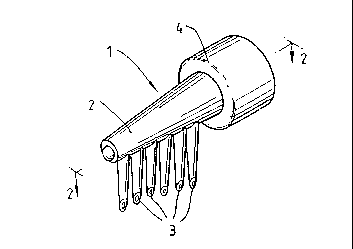Some of the information on this Web page has been provided by external sources. The Government of Canada is not responsible for the accuracy, reliability or currency of the information supplied by external sources. Users wishing to rely upon this information should consult directly with the source of the information. Content provided by external sources is not subject to official languages, privacy and accessibility requirements.
Any discrepancies in the text and image of the Claims and Abstract are due to differing posting times. Text of the Claims and Abstract are posted:
| (12) Patent Application: | (11) CA 2198493 |
|---|---|
| (54) English Title: | DISPENSING NOZZLE |
| (54) French Title: | BUSE DE DISTRIBUTION DE LIQUIDES |
| Status: | Deemed Abandoned and Beyond the Period of Reinstatement - Pending Response to Notice of Disregarded Communication |
| (51) International Patent Classification (IPC): |
|
|---|---|
| (72) Inventors : |
|
| (73) Owners : |
|
| (71) Applicants : |
|
| (74) Agent: | MOFFAT & CO. |
| (74) Associate agent: | |
| (45) Issued: | |
| (86) PCT Filing Date: | 1995-08-14 |
| (87) Open to Public Inspection: | 1996-03-07 |
| Examination requested: | 1997-02-25 |
| Availability of licence: | N/A |
| Dedicated to the Public: | N/A |
| (25) Language of filing: | English |
| Patent Cooperation Treaty (PCT): | Yes |
|---|---|
| (86) PCT Filing Number: | PCT/AU1995/000486 |
| (87) International Publication Number: | WO 1996006686 |
| (85) National Entry: | 1997-02-25 |
| (30) Application Priority Data: | ||||||
|---|---|---|---|---|---|---|
|
A dispensing nozzle (1) which is adapted to be connected to a container of
liquid and which has a dispensing head (2) which has a plurality of nozzles
(3) associated therewith. This dispensing nozzle (1) permits a more ready and
even distribution of liquids to required areas.
Buse de distribution (1) conçue pour être raccordée à un récipient de liquide et comportant une tête distributrice (2) présentant une série de buses (3). Cette buse de distribution (1) permet de déverser plus facilement et de manière plus uniforme des liquides aux endroits désirés.
Note: Claims are shown in the official language in which they were submitted.
Note: Descriptions are shown in the official language in which they were submitted.

2024-08-01:As part of the Next Generation Patents (NGP) transition, the Canadian Patents Database (CPD) now contains a more detailed Event History, which replicates the Event Log of our new back-office solution.
Please note that "Inactive:" events refers to events no longer in use in our new back-office solution.
For a clearer understanding of the status of the application/patent presented on this page, the site Disclaimer , as well as the definitions for Patent , Event History , Maintenance Fee and Payment History should be consulted.
| Description | Date |
|---|---|
| Inactive: IPC from MCD | 2006-03-12 |
| Inactive: IPC from MCD | 2006-03-12 |
| Inactive: IPC from MCD | 2006-03-12 |
| Inactive: IPC from MCD | 2006-03-12 |
| Inactive: Dead - No reply to s.30(2) Rules requisition | 2004-02-16 |
| Application Not Reinstated by Deadline | 2004-02-16 |
| Deemed Abandoned - Failure to Respond to Maintenance Fee Notice | 2003-08-14 |
| Inactive: Abandoned - No reply to s.30(2) Rules requisition | 2003-02-14 |
| Inactive: Entity size changed | 2002-08-29 |
| Inactive: S.30(2) Rules - Examiner requisition | 2002-08-14 |
| Inactive: Application prosecuted on TS as of Log entry date | 2001-05-03 |
| Inactive: Status info is complete as of Log entry date | 2001-03-12 |
| Amendment Received - Voluntary Amendment | 2001-01-05 |
| Inactive: Adhoc Request Documented | 2000-06-22 |
| Inactive: Delete abandonment | 2000-06-22 |
| Inactive: Abandoned - No reply to s.30(2) Rules requisition | 2000-04-04 |
| Inactive: S.30(2) Rules - Examiner requisition | 1999-10-04 |
| Inactive: Adhoc Request Documented | 1999-06-21 |
| Inactive: Delete abandonment | 1999-06-21 |
| Inactive: Abandoned - No reply to s.30(2) Rules requisition | 1999-03-09 |
| Inactive: S.30(2) Rules - Examiner requisition | 1998-11-09 |
| Inactive: S.30(2) Rules - Examiner requisition | 1998-11-09 |
| Inactive: Inventor deleted | 1997-08-27 |
| Inactive: Applicant deleted | 1997-08-27 |
| All Requirements for Examination Determined Compliant | 1997-02-25 |
| Request for Examination Requirements Determined Compliant | 1997-02-25 |
| Application Published (Open to Public Inspection) | 1996-03-07 |
| Abandonment Date | Reason | Reinstatement Date |
|---|---|---|
| 2003-08-14 |
The last payment was received on 2002-08-14
Note : If the full payment has not been received on or before the date indicated, a further fee may be required which may be one of the following
Please refer to the CIPO Patent Fees web page to see all current fee amounts.
| Fee Type | Anniversary Year | Due Date | Paid Date |
|---|---|---|---|
| MF (application, 3rd anniv.) - small | 03 | 1998-08-14 | 1998-05-06 |
| MF (application, 4th anniv.) - small | 04 | 1999-08-17 | 1999-08-13 |
| MF (application, 5th anniv.) - small | 05 | 2000-08-14 | 2000-07-07 |
| MF (application, 6th anniv.) - small | 06 | 2001-08-14 | 2001-08-07 |
| MF (application, 7th anniv.) - standard | 07 | 2002-08-14 | 2002-08-14 |
Note: Records showing the ownership history in alphabetical order.
| Current Owners on Record |
|---|
| PHILLIP GAZZO |
| Past Owners on Record |
|---|
| None |